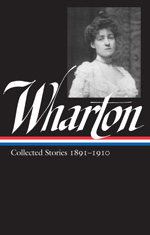From American Food Writing: An Anthology With Classic Recipes
Interesting Links
Opulence in the “Gilded Age,” 1890 (Eyewitness to History)
“Evander Berry Wall, King of the Dudes” (Ciaran Conliffe, HeadStuff)
Buy the book
 American Food Writing: An Anthology With Classic Recipes
American Food Writing: An Anthology With Classic Recipes
Paperback • 753 pages
List price: $24.00
Web store price: $14.95
Opulence in the “Gilded Age,” 1890 (Eyewitness to History)
“Evander Berry Wall, King of the Dudes” (Ciaran Conliffe, HeadStuff)
Buy the book
 American Food Writing: An Anthology With Classic Recipes
American Food Writing: An Anthology With Classic RecipesPaperback • 753 pages
List price: $24.00
Web store price: $14.95
 |
| Caricature of Ward McAllister as “an ass” telling Uncle Sam to imitate “an English Snob.” Image courtesy of Wikimedia Commons. |
McAllister, who earned the sobriquet “Make-a-lister,” formulated New York’s A-list, which he dubbed the “Four Hundred,” a reference to the number of guests who could comfortably fit into Mrs. Astor’s ballroom. Notably lacking at these events were artists and intellectuals; Edith Wharton attended once and was chagrined to note, in A Backward Glance, that instead of the “Bohemians” she had been led to expect, “the tiara-ed heads and bulging white waistcoats of the most accredited millionaires glittered between gold plate and orchids.” Evander Berry Wall, an heir to a fortune and the most famous of the New York “dudes,” quipped, “Remember that Broadway only cuts across Fifth Avenue—it never parallels it.”
In Who Killed Society?, Cleveland Amory summarizes, “without the slightest hint of a sense of humor, [McAllister] imparted such seriousness to his ideas, as well as to himself, that in the socially insecure times in which he lived he was soon taken extremely seriously even by people who should have known better.” But eventually this artifice imploded, and the fuse was his book Society As I Have Found It (1890). On its publication, William Dean Howells wrote in Harper’s, “It is always and everywhere amusing to see a plutocracy trying to turn into an aristocracy, and that is what Mr. McAllister shows us with no apparent sense of its comicality.” That the nation’s readers were suddenly laughing at McAllister’s prosperous peers did little for his standing among them, and he soon found himself persona non grata among the very society he thought he had made.
Yet, as a reviewer of his book in The New York Times noted, “our leader of society is not weak on all points. The man seriously knows something about eating and drinking. Being a cousin of Sam Ward must count for something.” The mention of McAllister’s cousin, Samuel Cutler Ward, brings us full circle, for not only was he a famous gourmet who ruled the Washington, DC, dinner circuit but he also married Emily Astor, the sister-in-law of “the Mrs. Astor.” The following selection makes reference to Ward McAllister’s “distinguished cousin” and his culinary authority as it describes with (mostly unintentional) comical aplomb the protocol for preparing a proper society dinner.
* * *
The first object to be aimed at is to make your dinners so charming and agreeable that invitations to them are eagerly sought for, and to let all feel that it is a great privilege to dine at your house, where they are sure they will meet only those whom they wish to meet. . . . If you don't see the full story below, click here (PDF) or click here (Google Docs) to read it—free!This selection may be photocopied and distributed for classroom or educational use.




